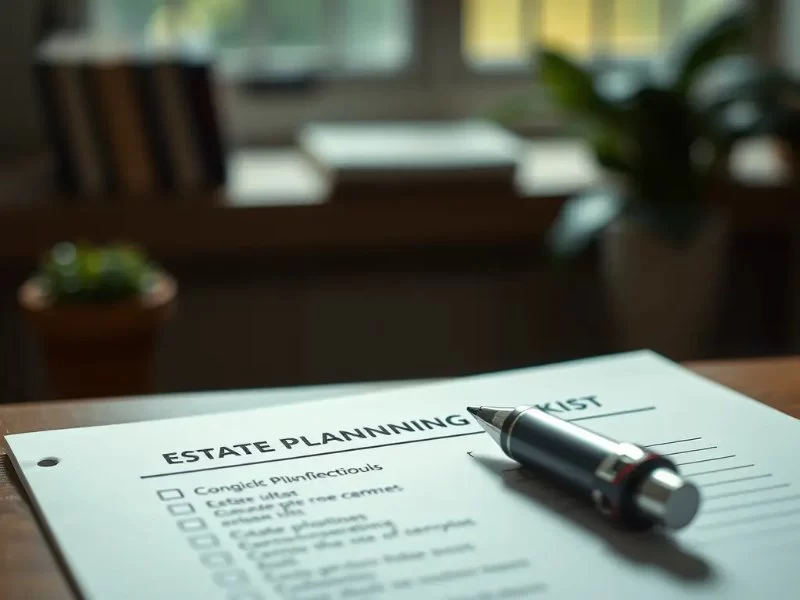What-to-Include-in-a-Comprehensive-Estate-Planning-Checklist - overview - key-elements - detailed-guidance
What-to-Include-in-a-Comprehensive-Estate-Planning-Checklist - documents - legal-structure - protection
What-to-Include-in-a-Comprehensive-Estate-Planning-Checklist - strategies - family-planning - advanced-considerations
What-to-Include-in-a-Comprehensive-Estate-Planning-Checklist - professional-support - legal-help - tips
Understanding the Purpose Behind a Thorough Estate Planning Checklist
Estate planning in the United States is often misunderstood as something meant only for wealthy families or individuals with complicated portfolios, but a closer look shows it's simply a structured approach to securing your future and protecting your loved ones. When discussing what to include in a comprehensive estate planning checklist, it helps to start by understanding why such a checklist matters. In recent years, several viral news stories—including unexpected celebrity deaths where estates were left in chaos—have reminded everyday families how critical it is to outline one’s intentions clearly before it is too late.
In practical terms, this type of planning is not just about distributing assets. It is about preventing disputes, setting medical preferences, appointing guardians for children, and making sure your personal values guide decisions even if you are unable to speak for yourself. As many attorneys note when helping clients, an estate plan gives families clarity during emotional times, and that is often just as valuable as the financial protection it provides.
What makes an estate plan “comprehensive” is the level of context, explanation, and foresight incorporated into it. Some people choose to include personal letters, ethical wills, and even recorded messages for their heirs. These may not be legal documents, but they make the planning feel more human and intentional. If you're unsure where to begin, platforms like Fred Miller Lawyer offer guidance on choosing the right legal services depending on your situation and needs.
Core Legal Documents That Form a Complete Estate Plan
To understand what to include in a comprehensive estate planning checklist, it is necessary to break down the essential documents that form the backbone of most estate plans. While every family’s situation is different, the following components tend to appear in well-prepared plans across the United States.
1. Last Will and Testament and Their Real-World Importance
The will remains the most recognized estate planning document, detailing how your assets should be distributed and who should care for your minor children. A widely discussed case involved an entrepreneur who passed away in 2022 without a will, resulting in a lengthy and public legal dispute among relatives who had never even met each other. Situations like that highlight exactly why outlining your wishes matters—your state’s intestacy laws may distribute your estate in a way you would have never chosen.
Within your will, personal property, real estate, and digital assets should all be addressed. As modern life becomes more digital, many attorneys now encourage clients to include login instructions, online business ownership details, and cryptocurrency information so heirs can avoid the frustration of inaccessible digital property.
2. Durable Power of Attorney and Long-Term Financial Protection
A durable power of attorney (POA) grants authority to someone you trust to manage financial matters if you become incapacitated. This may include handling taxes, real estate decisions, debt obligations, and personal business affairs. Without this document, your loved ones may face court delays and expensive guardianship proceedings before they are legally allowed to help you. A well-prepared POA ensures continuity and prevents financial damage during periods of illness or disability.
3. Advance Healthcare Directive and Your Medical Preferences
An advance healthcare directive outlines your wishes for medical treatment in situations where you cannot communicate. This includes life support preferences, organ donation choices, and decisions regarding pain management. Hospitals across the country regularly face conflicts between family members when these documents are missing. By identifying healthcare agents and detailing your preferences, you reduce stress for your family and ensure your medical care aligns with your values.
4. Revocable Living Trusts for Flexibility and Asset Management
For many U.S. families, a living trust becomes the most effective tool for managing assets smoothly and avoiding probate. Trusts allow assets to be transferred privately and efficiently, reducing delays and costs. They are especially useful for families with multiple real estate holdings, blended families, or long-term financial strategies. A revocable trust gives you the ability to modify the terms at any time, making it ideal for individuals who anticipate life changes or evolving financial priorities.
Strategies, Fine Details, and Long-Term Planning Considerations
Once your foundational documents are established, a comprehensive estate planning checklist should move deeper into long-term personal, financial, and family considerations. These strategic layers often strengthen the overall plan and make it more reflective of your real intentions.
1. Beneficiary Reviews and Coordination Across Accounts
Retirement accounts, life insurance policies, and investment platforms each require beneficiary designations. What surprises many people is that these designations override the instructions in a will. Stories circulate online every year of ex-spouses receiving unexpected inheritances simply because beneficiary lists were never updated. Reviewing these regularly is essential, especially after major life events such as marriage, divorce, birth of a child, or relocation to another state.
2. Asset Inventory and The Value of Documentation
Creating a full inventory of your assets—from bank accounts to collections and even sentimental family items—helps your executor and heirs understand what exists and how to access it. Many attorneys recommend maintaining a secure digital folder updated annually. Including instructions, contacts for financial advisors, and policy details can significantly reduce the burden on your family.
3. Plans for Children, Dependents, and Family Dynamics
Families with young children or dependents with special needs should include guardianship plans and special needs trusts as part of their estate checklist. These documents ensure financial resources are protected and used appropriately. Discussions about guardianship may be emotionally difficult, but addressing them proactively prevents uncertainty later.
4. Tax Considerations and State-Specific Rules
Estate taxes vary widely across states. Some states impose inheritance taxes, while others have none at all. Working with professionals who understand local laws helps you reduce tax burdens and increase the amount passed on to your heirs. This is particularly important for families with property across multiple states, business ownership, or high-value assets.
How Professionals Can Strengthen Your Estate Plan
Understanding what to include in a comprehensive estate planning checklist is only half the process; executing the documents correctly and ensuring they comply with state laws is equally important. There have been numerous cases where individuals downloaded template documents only to discover they were invalid due to missing signatures, improper witnessing, or state-specific legal requirements.
This is where experienced legal support becomes invaluable. Estate planning attorneys identify gaps, anticipate future complications, and make recommendations tailored to your family dynamics and financial goals. If you need assistance determining the right structure or simply want to confirm that your documents meet legal standards, you can explore guidance and services available through Fred Miller Lawyer, which helps clients ensure their planning is both thorough and legally sound.
By combining formal documents with thoughtful personal considerations and professional insight, your estate planning checklist becomes a powerful roadmap. It provides long-term clarity, protects loved ones, and ensures that your legacy reflects your values.


 271 north ave
271 north ave james mcelroy & diehl pa
james mcelroy & diehl pa tran law firm pllc
tran law firm pllc sugar law group
sugar law group zabriskie law firm
zabriskie law firm hogan vandenberg
hogan vandenberg